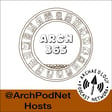Become a Creator today!Start creating today - Share your story with the world!
Start for free
00:00:00
00:00:01

Valsgarde - Episode 18030
The cemetery hill at Valsgärde, in use for five hundred years, provides an unparalleled insight into elite life and death in Sweden during the tail end of the Migration Period, through the Vendel Age, and into the Viking Age.
Recommended
Transcript
Insights into Elite Life at Cemetery Hill
00:00:01
Speaker
You're listening to the Archaeology Podcast Network. The Cemetery Hill at Valsgard, in use for 500 years, provides an unparalleled insight into the elite life and death in Sweden during the tail end of the migration period through the Wendell age and into the Viking age. You're in luck, folks, because this is episode 30 for January 30th, 2018. You've made it through 30 episodes of ARC 365.
Introduction to ARC 365 Podcast
00:00:27
Speaker
I'm Chris Webster and welcome to the ARC 365 podcast, 2018 edition. ARC 365 is a podcast today, every day, in 2018. This episode is written by Christopher
Archaeological Significance of Valsgard
00:00:36
Speaker
Booth. Velsgard is currently the site of a 16th century farm on the Ferris River about three kilometers north of Gamla Apsala, the ancient center of the Swedish kings, and five kilometers north of the present city of Apsala.
00:00:48
Speaker
This farm, however, has great archaeological significance. Traces of about 80 graves can be seen as mounds or oblong depressions in the slight plateau above the river clay that makes up the ground nearby. These are the remains of chamber tombs, cyst tombs, cremation burials, and boat burials, which form one of the most important ancient burial sites in Scandinavia.
Elite Burials and Chamber Tombs
00:01:08
Speaker
The first burials of Valsgard are a few chamber tombs dating to the migration period, 375 to 550.
00:01:14
Speaker
They may have contained rich grave goods, but they were opened, and any objects were removed shortly after they were constructed. However, the very existence of this kind of complex and expensive burial tradition demonstrates that there was already an elite presence at Valsgard. This elite presence seemed to have continued not unexpectedly, given the proximity of Gamla Uppsala into the Vandal Age, 550-793, and the Viking Age.
00:01:37
Speaker
The last graves of the site are dated to the 11th century. Though the burial traditions changed through this period, the site continued to be used mainly or exclusively for the social elite and the form of burial and the goods interred can both be interpreted as expressions of an aristocratic lifestyle and identity.
Boat Burials and Royal Connections
00:01:53
Speaker
The majority of the burials at the site took place in the Wendell Age and amongst them are the most famous burials at the site, boat burials. The first boat burial took place at the start of the 7th century and for the following three centuries into the Viking Age. This tradition continued at Valsgard in total there were 15 boat burials at this site and all were richly furnished.
00:02:11
Speaker
Only men appear to have been buried in boats, and the number and dating of this kind of burial suggests that only one man in each generation was buried this way, possibly the king. This would mirror other comparable boat burial sites, including Sutton Hoo in England, which we covered in an episode earlier this year. Boat burial of male elites is not the only similarity between Sutton Hoo and Val's Guard. The grave goods, especially the design of the shield and the helmet, are also very similar in the 7th century burials.
Transition in Burial Practices
00:02:38
Speaker
Towards the end of the period for use of this burial place, the boat burial tradition ended and the dead were buried in chamber or cis tombs as they had been before the 7th century. The cemetery also contained 60 cremation burials, which are contemporary with the boat graves. Often these individuals were women, but there are also cremations of men and children. The site was initially excavated by archaeologists in the 1920s after a similar site at Wendell, which gives this name to the period, had been excavated in the 19th century.
00:03:05
Speaker
The graves at Vental are comparable to Valsgard for the use of boat burial, and the forms of helmets and swords which also make it a comparable site to Sutton Hoo.
Who Were the Valsgard Burials?
00:03:14
Speaker
There are several theories about the identities of those buried at Valsgard, ranging from the Yinglings, the oldest known Scandinavian dynasty, to powerful warriors within the conscription system known to be in use by the kings in this period. There are so many rich graves that it is likely that most of them are royalty of some kind. Thank you.
00:03:37
Speaker
Thanks for listening to Arc 365.
Supporting ARC 365 and the Network
00:03:39
Speaker
If you want to hear more Arc 365, check out www.arcpodnet.com slash Arc 365 for the 2017 and 2018 episodes. Check out arcpodnet.com slash Arc 365 dash G30 for the last 30 episodes. Please subscribe and rate on your service of choice. We're available on iTunes, Stitcher, and Google Play among others. Support the APN at arcpodnet.com slash members. Thanks for listening and thanks for being awesome.
00:04:07
Speaker
This show is produced and recorded by the Archaeology Podcast Network, Chris Webster and Tristan Boyle, in Reno, Nevada at the Reno Collective. This has been a presentation of the Archaeology Podcast Network. Visit us on the web for show notes and other podcasts at www.archpodnet.com. Contact us at chrisatarchaeologypodcastnetwork.com.
